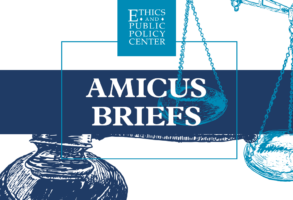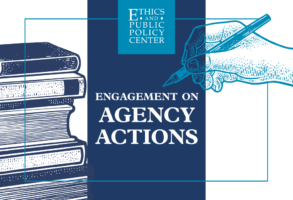July 13, 2022 | The Public Discourse
On July 7th, 2022, The Public Discourse published the transcript of a conversation between Dr. Stanley Goldfarb and EPPC Tikvah Visiting Fellow Devorah Goldman. The two discussed Dr. Goldfarb’s new book, Take Two Aspirin and Call Me By My Pronouns, which tracks the rise of social justice ideology in the medical field.
Read the transcript below or on The Public Discourse’s website.
Devorah Goldman: Welcome, Dr. Goldfarb, and congratulations on your excellent new book, which is an important and sweeping indictment of the medical establishment. What inspired you to write it?
Stanley Goldfarb: After nearly a dozen years directing the curriculum at the University of Pennsylvania Perelman School of Medicine, I began to detect a disturbing trend in medical schools around the nation. Directors of medical education, including a newly appointed director at Perelman, increasingly emphasized the so-called social determinants of health in school programming. They also implemented a range of initiatives that downgraded the value of academic achievement in both the basis for admission to medical school and the assessment systems associated with progression through the curriculum. After observing this for several years, I felt compelled to speak out about my concerns. I wrote an op-ed for the Wall Street Journal in September 2019 in which I highlighted my apprehensions about the direction of medical education, and proposed a restored focus on medical science and a limit on instruction in social issues.
The op-ed sparked a response from my school. The administration made it exceedingly clear that my opinions did not reflect the official positions of Perelman, and they affirmed the school’s commitment to diversity and inclusion in determining its student body. The title of my article, provided by the Wall Street Journal staff, Take Two Aspirin and Call Me by My Pronouns, also elicited critical responses from the American College of Physicians and Penn alumni, as well as virulent commentary on social media.
It became apparent that I needed to more thoroughly detail my concerns and to identify the growing weakness of American medical education. That realization led to this book.
DG: You write in your book that those doctors who “challenge the idea of systemic racism might as well exchange their white lab coats for white sheets,” and that social-justice skeptics like you “are on the run.” These are strong words, but they point to the fact that there’s a great deal at stake for dissenters. How has this played out in your professional life?
SG: Perhaps a bit hyperbolic, but clearly the prevailing zeitgeist of American medical education is an almost complete and unthinking acceptance of a “woke” mentality. The demonstrations at academic medical centers and medical schools throughout the United States following George Floyd’s killing led to widespread declarations of the need to purge “systemic racism” from American medicine and to adopt “antiracism” as a dominant aspect of the medical ethos.
In the words of Dr. Ibram X. Kendi, one of the prophets of anti-racism, future discrimination in favor of black individuals must help atone for past discrimination against black individuals. In medical care, this has come to mean discrimination against one group of patients to benefit another group, all on the basis of skin color. It also means discriminating against some applicants to medical school, as well as academics seeking career advancement.
I am at the end of my medical career so for me, the real impact relates to the concerns expressed to me, typically confidentially, by colleagues who agree with my positions but are afraid to speak out. Even the mildest dissent from the dominant narrative could mean losing a job. That is what happened to Dr. Edward Livingstone, formerly the deputy editor of the Journal of the American Medical Association. He had the temerity to suggest on a podcast that “systemic racism” was an unfortunate designation for a set of conditions that were more closely tied to poverty than to widespread oppression based on skin color. He was summarily forced out of his position.
DG: You also note in the book that “the idea that physicians are responsible for correcting [health inequities] among different communities” gained credence after World War II. As an example, you cite the World Health Organization’s 1978 Alma-Alta Declaration, and contrast it with the Hippocratic Oath. Can you say a bit more about the conflict of visions here?
SG: It is basically the conflict between the idea that medical care should focus on large-scale prevention and population-level health measures, i.e., on group behavior, and the belief that we as physicians should channel our energies toward the particular problems of individual patients. The traditional Hippocratic Oath speaks to a code of conduct demanding loyalty without discrimination to each individual patient, unrelated to any social, economic or ideological factors at play. It defines the way physicians should focus on the care of the individual to the exclusion of any personal gain and to apply all of the physician’s capacities to the care of that patient.
The Alma-Alta Declaration, as I wrote in my book, calls for a very different perspective. It puts forth a vision for primary health care that “addresses the main health problems in the community, providing promotive, preventive, curative and rehabilitative services accordingly.” The role of the physician in this scenario includes the following:
. . . education concerning prevailing health problems and the methods of preventing and controlling them; promotion of food supply and proper nutrition; an adequate supply of safe water and basic sanitation; maternal and child health care, including family planning; immunization against the major infectious diseases; prevention and control of locally endemic diseases; appropriate treatment of common diseases and injuries; and provision of essential drugs.
The Declaration expands the role of the physician into that of a public-health worker responsible for broad social and political conditions. It calls for physicians to insert themselves into issues over which they have scant expertise and control. Expending time, energy, and resources into such endeavors must detract from the time and effort required to provide the best possible medical care to individual patients.
DG: It should also be emphasized that real medical expertise is difficult to attain; it is the product of years of experience even after medical school. We shouldn’t take it for granted or assume that layering on additional responsibilities will not affect the quality of medical care. On that note, why do you think “woke medicine” has gained the upper hand in so many medical institutions? What are some of the dangers you see as inherent in this approach?
SG: I think it is part and parcel of the leftward movement in undergraduate and graduate education in general. Dickens called the impulse to do good the “sanguine mirage of good minds.” No doubt there is such an impulse in practitioners of woke medicine, but they are fooling themselves. They see disparate outcomes in health care, and they feel guilty and blame themselves. Many academic doctors also see a willing cohort of impressionable students who are reared in Marxist ideas about power hierarchies, and they demand that the students adhere to their concepts of equity.
On the more cynical side, I see administrators and medical leaders who simply do not want to face the wrath of their woke students; they have decided that it is easier to “talk the talk,” while delaying actually doing anything substantively “woke” that would require massive expenditures. For example, it is easier to accept a few more minority students or hire a few more diversity specialists than it is to open outpatient facilities in black neighborhoods—a move that might actually improve outcomes for black patients.
We have already seen some of the dangers of woke medicine. Earlier in the COVID pandemic, a movement arose to reserve use of scarce drugs like monoclonal antibodies for black patients. An algorithm was used by institutions in New York and Utah, in which “black skin color” garnered two of the six points needed to qualify for use of the drugs. In this system, a relatively well black patient might receive the drug rather than a white patient facing a more dire clinical situation. This is pure racial discrimination and it has no place in medical care.
This is just one disturbing example, among many, in which the implications of woke medicine are clear—and must be rejected. Physicians may not feel comfortable arguing against reduced standards for admission to medical school or to residency training programs. But they must at least stand up against active racial discrimination in health care.
DG: Another problem you point out involves “zombie statistics”—the phenomenon whereby false or misleading figures, often from poorly conducted or fraudulent studies, take on a life of their own. They are widely cited and eventually turned into easy talking points or conventional wisdom. What are some notable examples of this, and do you see a viable way to push back against any of it?
SG: My book cites several examples, but it goes on and on. The problem is not only in the way the studies are designed and evaluated but also in the way the conclusions are drawn.
For example, one study that is cited extensively in the medical literature as proof of racism in medicine actually found no difference in the way clinicians would treat black and white men with heart symptoms after providing the physicians with similar clinical information about the two cohorts. Black women, however, were referred less frequently for invasive studies than white women with similar complaints. All the “patients” were simulated by actors on videos. This study does not explain the differing recommendations based on gender but it may have roots in medical information available in 1999, when it was conducted.
A very recent study in the journal Academic Medicine found that “underrepresented in medicine” residents, or URiM residents, received lower ratings than other medical residents at a number of academic institutions that pooled their data. The authors concluded that one of three possibilities explained the results:
Resident race/ethnicity was associated with assessment scores to the disadvantage of URiM residents. This may reflect bias in faculty assessment, effects of a non-inclusive learning environment, or structural inequities in assessment.
Incredibly, the authors could not bring themselves to consider the possibility that the assessments were accurate and that the URiM residents performed less well than their peers. Any inequality must be the fault of the school, the result of a power differential between white racists and black students. This is an amazing blind spot. It could be the poster child for all the problems with adopting “antiracist” approaches in health care and education.
The only way to combat this is to point out the flaws and use social media and other platforms to fight the disinformation. It is a long and slow struggle but we cannot give it up.
DG: Earlier, you mentioned the issue of medical school applications. In recent years, the Medical College Admissions Test (MCAT) and other admissions criteria have become politicized, as have many medical school courses. In particular, under the leadership of Dr. Darrell Kirch, the American Association of Medical Colleges has introduced sweeping changes to the MCAT, which now serves in part as a sort of screening mechanism for progressive orthodoxy.
What do you make of this, and do you think there’s any possibility of reform here? What advice might you give young people considering a medical career?
SG: It is quite simple. To hide the fact that admission to medical school can now be based on factors other than academic achievement, one needs to reduce evidence of academic achievement as much as possible. It’s not to say that there aren’t really bright people being recruited into medical school, but to create the highly valued “D” in DEI, it’s important to be able to skirt the issue of academic performance when that helps. It only works if you don’t believe in meritocracy, a concept that brings rage to the woke elite.
Reform seems far off unless legal challenges to affirmative action, such as the Harvard case now before the Supreme Court, eliminate the unfair practice of race-based policies.
Medicine is a great career. I would never discourage anyone from pursuing it. Every sphere of life deserves examination and reform, if necessary. Medicine is no different.
DG: Your own medical career is obviously extremely impressive, but you’ve recently pivoted, and now run the nonprofit Do No Harm. Can you tell us a bit about Do No Harm—why you launched it and your hopes for its future?
SG: I launched Do No Harm together with several colleagues in the hope of providing a voice for physicians who wish to point out racial discrimination in health care. Our aim is to employ social media, other forms of media, and even legal remedies to challenge the harmful trends threatening American medicine.
Do No Harm is a membership organization, through which physicians and others interested in health care can share information about discriminatory practices they encounter and the corruption of research into healthcare disparities. We helped support a lawsuit against the federal government after discovering that new Medicare rules propose that physicians who create “antiracism protocols” in their care of Medicare patients will be eligible for bonus payments. Such protocols suggest discriminatory practice based on race, and would therefore seem to be illegal and unconstitutional. We are helping two physicians who have been injured by this rule to sue the government to rescind the rule. Eight states have joined the suit.
We have also called out the University of Indiana School of Medicine for demanding that faculty create a “DEI” proposal if they wish to be considered for academic promotion. This flies in the face of academic freedom and the First Amendment.
We will be calling out institutions that have adopted discriminatory practices in hiring, promotion, and patient care.
We need to start the return to meritocracy and non-discrimination in health care. No doubt it will be a long journey but we will hopefully have some fun along the way.
Devorah Goldman is EPPC’s Tikvah Visiting Fellow. Her work focuses primarily on religion, medical culture, and public bioethics.







